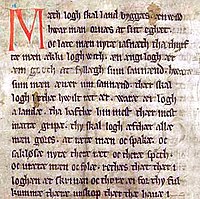 Global Information
Global InformationDanish language information
| Danish | |
|---|---|
| dansk | |
 The first page of the Jutlandic Law originally from 1241 in Codex Holmiensis, copied in 1350. The first sentence is: "Mæth logh skal land byggas" Modern orthography: "Med lov skal land bygges" English translation: "With law shall a country be built" | |
| Pronunciation | [ˈtænˀsk][1] |
| Native to |
|
| Region | Denmark, Schleswig-Holstein (Germany); Additionally in the Faroe Islands and Greenland |
| Ethnicity |
|
Native speakers | 6.0 million (2019)[2] |
Language family | Indo-European
|
Early forms | Old Norse
|
| Dialects |
|
Writing system |
|
| Official status | |
Official language in |
|
Recognised minority language in |
|
| Regulated by | Dansk Sprognævn (Danish Language Council) |
| Language codes | |
| ISO 639-1 | da |
| ISO 639-2 | dan |
| ISO 639-3 | Either:dan – Insular Danishjut – Jutlandic |
| Glottolog | dani1285 Danishjuti1236 Jutish |
| Linguasphere | 5 2-AAA-bf & -ca to -cj |
 Dark Blue: Spoken by a majority
Light Blue: Spoken by a minority | |
Danish (/ˈdeɪnɪʃ/ ⓘ, DAY-nish; endonym: dansk pronounced [ˈtænˀsk] ⓘ, dansk sprog [ˈtænˀsk ˈspʁɔwˀ])[1] is a North Germanic language spoken by about six million people, principally in and around Denmark. Communities of Danish speakers are also found in Greenland,[5] the Faroe Islands, and the northern German region of Southern Schleswig, where it has minority language status.[6][7] Minor Danish-speaking communities are also found in Norway, Sweden, the United States, Canada, Brazil, and Argentina.[8]
Along with the other North Germanic languages, Danish is a descendant of Old Norse, the common language of the Germanic peoples who lived in Scandinavia during the Viking Era. Danish, together with Swedish, derives from the East Norse dialect group, while the Middle Norwegian language (before the influence of Danish) and Norwegian Bokmål are classified as West Norse along with Faroese and Icelandic. A more recent classification based on mutual intelligibility separates modern spoken Danish, Norwegian, and Swedish as "mainland (or continental) Scandinavian", while Icelandic and Faroese are classified as "insular Scandinavian". Although the written languages are compatible, spoken Danish is distinctly different from Norwegian and Swedish and thus the degree of mutual intelligibility with either is variable between regions and speakers.
Until the 16th century, Danish was a continuum of dialects spoken from Southern Jutland and Schleswig to Scania with no standard variety or spelling conventions. With the Protestant Reformation and the introduction of the printing press, a standard language was developed which was based on the educated dialect of Copenhagen and Malmö.[9] It spread through use in the education system and administration, though German and Latin continued to be the most important written languages well into the 17th century. Following the loss of territory to Germany and Sweden, a nationalist movement adopted the language as a token of Danish identity, and the language experienced a strong surge in use and popularity, with major works of literature produced in the 18th and 19th centuries. Today, traditional Danish dialects have all but disappeared, though regional variants of the standard language exist. The main differences in language are between generations, with youth language being particularly innovative.
Danish has a very large vowel inventory consisting of 27 phonemically distinctive vowels,[10] and its prosody is characterized by the distinctive phenomenon stød, a kind of laryngeal phonation type. Due to the many pronunciation differences that set Danish apart from its neighboring languages, particularly the vowels, difficult prosody and "weakly" pronounced consonants, it is sometimes considered to be a "difficult language to learn, acquire and understand",[11][12] and some evidence shows that children are slower to acquire the phonological distinctions of Danish compared to other languages.[13] The grammar is moderately inflective with strong (irregular) and weak (regular) conjugations and inflections. Nouns, adjectives, and demonstrative pronouns distinguish common and neutral gender. Like English, Danish only has remnants of a former case system, particularly in the pronouns. Unlike English, it has lost all person marking on verbs. Its word order is V2, with the finite verb always occupying the second slot in the sentence.
- ^ a b "dansk – Den Danske Ordbog". ordnet.dk.
- ^ Insular Danish at Ethnologue (18th ed., 2015) (subscription required)
Jutlandic at Ethnologue (18th ed., 2015) (subscription required) - ^ Hammarström, Harald; Forkel, Robert; Haspelmath, Martin; Bank, Sebastian (24 May 2022). "Older Runic". Glottolog. Max Planck Institute for Evolutionary Anthropology. Archived from the original on 13 November 2022. Retrieved 13 November 2022.
- ^ Hammarström, Harald; Forkel, Robert; Haspelmath, Martin, eds. (2017). "Danish language". Glottolog 3.0. Jena, Germany: Max Planck Institute for the Science of Human History.
- ^ Frederiksen & Olsen 2017.
- ^ Cite error: The named reference
deofficial-lawwas invoked but never defined (see the help page). - ^ Cite error: The named reference
deofficial-tvsydwas invoked but never defined (see the help page). - ^ Kühl, Petersen & Hansen 2020.
- ^ Dal 1991.
- ^ Haberland 1994, p. 318.
- ^ Grønnum 2008a.
- ^ Grønnum 2008b.
- ^ Trecca et al. 2020.